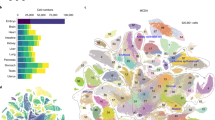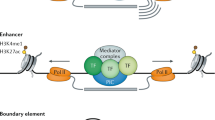Abstract
In multicellular organisms, cells usually respond to signals that they encounter in a manner that depends on their particular lineage 'identity'. In other words, cells that have identical genomes can respond in markedly different ways to the same stimulus, with the outcome being determined largely by the previous developmental history of the cell. This general observation implies that individual somatic cells retain a 'working memory' of their ancestry and that this epigenetic information can be passed through successive rounds of DNA replication and cell division. Here, I discuss whether recent advances in our knowledge of chromatin biology and gene silencing can provide new insights into how cell fate is chosen and maintained during development.
This is a preview of subscription content, access via your institution
Access options
Subscribe to this journal
Receive 12 print issues and online access
$209.00 per year
only $17.42 per issue
Buy this article
- Purchase on Springer Link
- Instant access to full article PDF
Prices may be subject to local taxes which are calculated during checkout



Similar content being viewed by others
References
Becket, A. J., MucCulloch, A. E. & Till, J. E. Cytological demonstration of the clonal nature of spleen colonies derived from transplanted mouse marrow cells. Nature 197, 452 (1963).
Abramson, S., Miler, R. G. & Phillips, R. A. The identification in adult bone marrow of pluripotent and restricted stem cells of the myeloid and lymphoid systems. J. Exp. Med. 145, 1567 –1579 (1977).
Akashi, K., Traver, D., Miyamoto, T. & Weissman, I. L. A clonogenic common myeloid progenitor that gives rise to all myeloid lineages. Nature 404, 193–197 (2000).
Kondo, M., Weissman, I. L. & Akashi, K. Clonogenic common lymphoid progenitors in mouse bone marrow. Cell 91, 661–672 (1997).
Miyamoto, T. et al. Myeloid or lymphoid promiscuity as a critical step in hematopoietic lineage commitment. Dev. Cell 3, 137–147 (2002).
Hu, M. et al. Multilineage gene expression precedes commitment in the hemopoietic system. Genes Dev. 11, 774–785 (1997).
Enver, T., Heyworth, C. M. & Dexter, T. M. Do stem cells play dice? Blood 92, 348–351 (1998).
De Krom, M., van de Corput, M., von Lindern, M., Grosveld, F. & Stouboulis, J. Stochastic patterns in globin gene expression are established prior to transcriptional activation and are clonally inheritied Mol. Cell 9, 1319–1326 (2002).
Festenstein, R. & Kioussis, D. Locus-control regions and epigenetic chromatin modifiers. Curr. Opin. Genet. Dev. 10, 199–203 (2000).
Brown, G., Bunce, C. M. & Guy, G. R. Sequential determination of lineage potentials during haemopoiesis. Br. J. Cancer 52, 681–686 (1985).
Novak, J. P. & Stewart, C. C. Stochastic versus deterministic in haemopoiesis: what is what? Br. J. Haematol. 78, 149–154 (1991).
Singh, H. Gene targeting reveals a hierarchy of transcription factors regulating specification of lymphoid cell fates. Curr. Opin. Immunol. 8, 160–165 (1996).
Lu, M., Kawamoto, H., Katsube, Y., Ikawa, T. & Katsura, Y. The myelolymphoid progenitor: a key intermediate stage in hemopoiesis generating T and B cells. J. Immunol. 169, 3519–3525 (2002).
Sieweke, M. H. & Graf, T. A transcription factor party during blood-cell differentiation. Curr. Opin. Genet. Dev. 8, 545–551 (1998).
Cantor, A. B. & Orkin, S. H. Transcriptional regulation of erythropoiesis: an affair involving multiple partners. Oncogene 21, 3368–3376 (2002).
Heyworth, C., Pearson, S., May, G. & Enver, T. Transcription factor-mediated lineage switching reveals plasticity in primary committed progenitor cells. EMBO J. 21, 3770–3781 (2002).
Rekhtman, N., Radparvar, F., Evans, T. & Skoultchi, A. I. Direct interaction of haemopoietic transcription factors PU.1 and GATA-1: functional antagonism in erythroid cells. Genes Dev. 13, 1398–1411 (1999).
Zhang, P. et al. PU.1 inhibits GATA-1 function and erythroid differentiation by blocking GATA-1 DNA binding. Blood 96, 2641–2648 (2000).
Visvader, J. E., Crossley, M., Hill, J., Orkin, S. H. & Adams, J. M. The C-terminal zinc finger of GATA-1 or GATA-2 is sufficient to induce megakaryocytic differentiation of an early myeloid cell line. Mol. Cell. Biol. 15, 634–641 (1995).
Kulessa, H., Frampton, J. & Graf, T. GATA-1 reprograms avian myelomonocytic cell lines into eosinophils, thromboblasts and erythrocytes. Genes Dev. 9, 1250–1262 (1995).
Lassar, A. B., Paterson, B. M. & Weintrub, H. Transfection of a DNA locus that mediates the conversion of 10T1/2 fibroblasts to myoblasts. Cell 47, 649–656 (1986).
Choi, J. et al. MyoD converts primary dermal fibroblasts, chondroblasts, smooth muscle and retinal pigmented epithelial cells into striated mononucleated myoblasts and multinucleated myotubes. Proc. Natl Acad. Sci. USA 87, 7988–7992 (1990).
Nutt, S. L., Heavey, B., Rolink, A. G. & Busslinger, M. Commitment to the B-lymphoid lineage depends on the transcription factor Pax5. Nature 401, 556–562 (1999).
Busslinger, M., Nutt, S. L. & Rolink, A. G. Lineage commitment in lymphopoiesis. Curr. Opin. Immunol. 2, 151–158 (2000).
Mikkola, I., Heavey, B., Horcher, M. & Busslinger, M. Reversion of B-cell commitment upon loss of Pax5 expression. Science 297, 110–113 (2002).
Horcher, M., Souabni, A. & Busslinger, M. Pax5/BSAP maintains the identity of B cells in late B lymphopoiesis. Immunity 6, 779–790 (2001).
Kozmik, Z., Wang, S., Dorfler, P., Adams, B. & Busslinger, M. The promoter of the CD19 gene is a target for the B-cell-specific transcription factor BSAP. Mol. Cell. Biol. 12, 2662–2672 (1992).
Eberhard, D., Jimenez, G., Heavey, B. & Busslinger, M. Transcriptional repression by Pax5 (BSAP) through interaction with corepressors of the Groucho family. EMBO J. 10, 2292–2303 (2000).
Fisher, A. G. & Merkenschlager, M. Gene silencing, cell fate and nuclear organisation. Curr. Opin. Genet. Dev. 12, 193–197 (2002).
Sieweke, M. H., Tekotte, H., Frampton, J. & Graf, T. MafB is an interaction partner and repressor of Ets-1 that inhibits erythroid differentiation. Cell 85, 49–60 (1996).
Zhang, P. et al. Negative cross-talk between hematopoietic regulators: GATA proteins repress PU.1. Proc. Natl Acad. Sci. USA 96, 8705–8710 (1996).
Nerlov, C., Querfurth, E., Kulessa, H. & Graf, T. GATA-1 interacts with the myeloid PU.1 transcription factor and represses PU.1-dependent transcription. Blood 95, 2543–2551 (2000).
Muhr, J., Anderson, E., Persson, M., Jessel, T. M. & Ericson, J. Groucho-mediated transcriptional repression establishes progenitor-cell pattern and neuronal fate in the ventral neural tube. Cell 104, 861–873 (2001).
Marquardt, T. & Pfaff, S. L. Cracking the transcriptional code for cell specification in the neural tube. Cell 106, 651–654 (2001).
Phillips, R. L. et al. The genetic program of hematopoietic stem cells. Science 288, 1635–1640 (2000).
Muschen, M. et al. Molecular portraits of B-cell lineage commitment. Proc. Natl Acad. Sci. USA 99, 10014–10019 (2002).
Ivanova, N. B. et al. A stem-cell molecular signature. Science 298, 601–604 (2002).
Holstege, F. C. & Young, R. A. Transcriptional regulation: contending with complexity. Proc. Natl Acad. Sci. USA 96, 2–4 (1999).
Ohlsson, R., Tycko, B. & Sapienza, C. Monoallelic expression: 'there can only be one'. Trends Genet. 11, 435–438 (1998).
Bird, A. The essentials of DNA methylation. Cell 70, 5–8 (1992).
Leonhardt, H., Page, A. W., Weier, H. U. & Bestor, T. H. A targeting sequence directs DNA methyltransferase to sites of DNA replication in mammalian nuclei. Cell 71, 865–873 (1992).
Bird, A. P. & Wolffe, A. P. Methylation-induced repression — belts, braces and chromatin. Cell 99, 451–454 (1999).
Allshire, R. & Bickmore, W. Pausing for thought on the boundaries of imprinting. Cell 102, 705–708 (2000).
Jenuwein, T. & Allis, C. D. Translating the histone code. Science 293, 1074–1080 (2001).
Gasser, S. M. Positions of potential: nuclear organization and gene expression. Cell 104, 639–642 (2001).
Zhang, Y. & Reinberg, D. Transcription regulation by histone methylation: interplay between different covalent modifications of the core histone tails. Genes Dev. 15, 2343–2360 (2002).
Lachner, M., O'Carroll, D., Rea, S., Mechtler, K. & Jenuwein, T. Methylation of histone H3 lysine-9 creates a binding site for HP1 proteins. Nature 410, 116–120 (2001).
Bannister, A. J. et al. Selective recognition of methylated lysine-9 on histone H3 by the HP1 chromo domain. Nature 410, 120–124 (2001).
Müller, J. et al. Histone methyltransferase activity of a Drosophila polycomb-group repressor complex. Cell 111, 197–208 (2002)
Czermin, B. et al. Drosophila enhancer of Zeste/ESC complexes have a histone H3 methyltransferase activity that marks chromosomal polycomb sites. Cell 111, 185–196 (2002).
Tamaru, H. & Selker, E. U. A histone H3 methyltransferase controls DNA methylation in Neurospora crassa. Nature 414, 277–283 (2001).
Bird, A. Molecular biology. Methylation talk between histones and DNA. Science 294, 2113–2115 (2002).
Gribnau, J., Diderich, K., Pruzina, S., Calzolari, R. & Fraser, P. Intergenic transcription and developmental remodeling of chromatin subdomains in the human β-globin locus. Mol. Cell 5, 377–386 (2000).
Schubeler, D. et al. Nuclear localization and histone acetylation: a pathway for chromatin opening and transcriptional activation of the human β-globin locus. Genes Dev. 14, 940–950 (2000).
Agarwal, S. & Rao, A. Modulation of chromatin structure regulates cytokine gene expression during T-cell differentiation. Immunity 9, 765–775 (1998).
Lee, D. U., Agarwal, S. & Rao, A. TH2-lineage commitment and efficient IL-4 production involves extended demethylation of the IL-4 gene. Immunity 16, 649–660 (2002).
Avni, O. et al. T(H)-cell differentiation is accompanied by dynamic changes in histone acetylation of cytokine genes. Nature Immunol. 3, 643–651 (2002).
Grogan, J. L. & Locksley, R. M. T-helper cell differentiation: on again, off again. Curr. Opin. Immunol. 3, 366–372 (2002).
Dernburg, A. F. et al. Perturbation of nuclear architecture by long-distance chromosome interactions. Cell 85, 745–759 (1996).
Francastel, C., Walters, M. C., Groudine, M. & Martin D. I. A functional enhancer suppresses silencing of a transgene and prevents its localization close to centromeric heterochromatin. Cell 99, 259–269 (1999).
Volpi, E. V. et al. Large-scale chromatin organization of the major histocompatibility complex and other regions of human chromosome 6 and its response to interferon in interphase nuclei. J. Cell Sci. 113, 1565–1576 (2000).
Williams, R. E., Broad, S., Sheer, D. & Ragoussis, J. Subchromosomal positioning of the epidermal differentiation complex (EDC) in keratinocyte and lymphoblast interphase nuclei. Exp. Cell Res. 272, 163–175 (2002).
Kosak, S. et al. Subnuclear compartmentalization of immunoglobulin loci during lymphocyte development. Science 296, 158–162 (2002).
Skok, J. A. et al. Nonequivalent nuclear location of immunoglobulin alleles in B lymphocytes. Nature Immunol. 2, 848–854 (2002).
Acknowledgements
I would like to thank my colleagues, in particular members of the Lymphocyte Development Group, for helpful discussions.
Author information
Authors and Affiliations
Rights and permissions
About this article
Cite this article
Fisher, A. Cellular identity and lineage choice. Nat Rev Immunol 2, 977–982 (2002). https://doi.org/10.1038/nri958
Issue Date:
DOI: https://doi.org/10.1038/nri958



